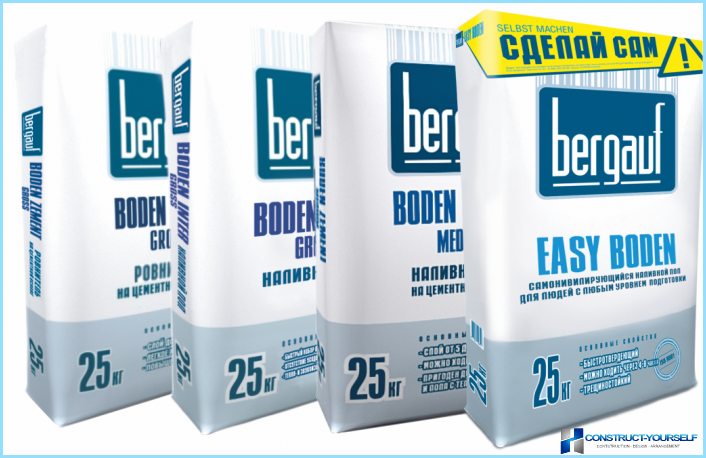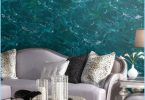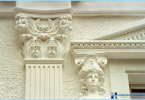The contents
A complete renovation includes replacement of flooring. The inevitable conversion put in front of consumers is a natural task to decide what kind of self-leveling mixture for floor is better? Traditional sand-cement screed was indispensible a couple of decades ago. Now to him I turn in case of serious damage the floor. Leveling the Foundation with plywood, chipboard or OSB material is better to use for wooden surface. But the subsequent finishing in the form of parquet or laminate needs to be perfectly flat base basis. So choose the floor for any mixture of self-leveling is an important task, the proper solution guarantees a long service life of floor covering.
What are the levelling mixes, the conditions in which they are applicable and what properties they have, deal details.

Best face applications ↑
If the floor in the room has a small difference in horizontal level and contains no significant damage, with better material to handle than a self-levelling floors and floor levelling you are unlikely to pick up. The dry mix has the following characteristics:
- A quick hardening of the mortar compared to the cement-sand screed. Depending on the thickness of the coating, the composition of the mixture, the manufacturer and ambient conditions, the process lasts from 8 to 48 hours.
- After curing, the mixture forms a durable surface that is resistant to water. Such a floor is not afraid of flooding from above, the screed self-leveling mortar will not miss the moisture on the lower floor.
- The surface of the floor made using the dry mix, it has a perfectly smooth texture. For the installation of further coatings do not require additional applications of the substrates.
- Self-leveling solution is not prone to cracking over time due to storing a certain degree of plasticity.
- Exploitation is possible in areas not equipped with heating.
- The weight of the self-leveling composition is significantly lower TSPS, so even a thick layer does not generate excessive floor load.
All these properties ensure the popularity of the application of levelling mixes in the repair of the floor.

Types of levelling mixes ↑
To determine which equalizer for the floor it is better to buy, you should be familiar with their classification. Depending on the components of they are:
- Gypsum or anhydrite. They have low weight and relatively low cost. Among the advantages there is also the flexibility and the possibility of formation of a layer with thickness up to 100 mm. However, when choosing you should consider the prohibition of their use in conditions of high humidity (80%)
- Cement mortars. Their versatility enables use in any environment without regard to the indicators of humidity. Allowable thickness is 60 mm. self-Leveling mixture with cement-based less plastic, has a larger weight compared to gypsum compositions and worse spread on the floor.
Dry room where it is planned the installation of a warm floor, it is best to choose the dry mix of plaster, finishing of industrial spaces is carried out exclusively self-leveling cement mixture. Depending on the purpose, levelling mixes are:
- Starting. This is a kind of replacement of the TSPS. Their sphere roughing the floor, which requires subsequent finishing materials with a smaller fraction. Popular levelling mixes flour leading brands Hercules, Stromiks, Plitonit P1, VOLMA.
- Manufacturers offer special self-leveling mix to correct minor flaws or floor correction screed.
- To obtain the smoothest possible floor surface released finish levelling mixes of self-leveling. In some cases, they serve as the final layer and do not require coating of the hard material in the form of laminate or wood flooring. To create original interior topcoat complement the individual pattern or an interesting ornament.
- There are self-leveling mortar, designed to restore a wooden base floor. Special fiber included in the composition of funds, enhance adhesion and provide high-quality screed wooden base.

The nuances of choice ↑
Studying a wide range of floor levelling mixes to determine from which self-leveling mortar is better, sometimes it is difficult. So, your actions:
- To identify the factors affecting the coating. Anhydrite self-levelling compound is not suitable for bathrooms, kitchens or other rooms with high humidity. It is better to produce the finish cement composition.
- To understand the components of the equalizer. If the grain size is greater than 1.5 mm, then you will receive a standard concrete floor. Self-leveling compound is provided that grain size is not more than 0.8 mm.
- To see the specifications. In addition to dry, there are dry compounds that differ in the structure of the mixing solution. After drying their appearance is similar to dry mixes.
- Pay attention to the permissible thickness of 1 layer. Usually the layer comprising the mixture does not exceed 3 cm When value of 5-8 cm you are holding a regular TSPS with the content of the polymer, the purpose of which is to accelerate the process of hardening solution.
- With the same parameters give preference to levelling mixes, designed to furnish warm floors. This will increase the level of insulation in the room.
- Better not to buy self-leveling mixture with expired. It may lose its properties, and the subfloor will get a low-quality.
- If you want to create a strong durable surface, it is better to stop the choice on two-component polyurethane compositions.
The price of the product determines the amount of plasticizer in the self-leveling mixture, their high content ensures the formation of high-quality floor surfaces and Vice versa.

Consumption calculation ↑
Due to fast hardening self-leveling compounds, to mix better the volume of the solution, which is enough to work for 1/3 hours. For the preparation of the composition taken for pure water, the temperature range which is +5 – + 20onC. per 1 kg of dry mix will need 130-150 grams of liquid. Depending on the purpose of the self-leveling composition, the estimated material consumption the following (based on final solution):
- Rough rovnitel for layer 1 mm thick is used in amount of 2-2,5 kg per 1 mTwo.
- For the final mixture the figure is 1.5-1.7 kg per 1 mTwo when the millimeter layer.
- Average consumption of self-levelling mortar for layer of 1 cm is 20 kg per square meter.

Overview of manufacturers ↑
The building materials market is saturated with a huge range of levelling mixes for flooring from different manufacturers. Among them find high-quality self-leveling compound can not only famous brands but also strangers. Good recommendations received brand Bergauf, VOLMA, Plitonit.
The users Bergauf offers:
- The starting mixture based on cement. For self-leveling mortar characterized by high flexibility, resistance to cracking, no shrinkage, could not be better suited for floor heating.
- Self-leveling high strength floor levelling mix, which forms a cement. Allows for easy leveling allows you to create a layer up to 5 cm, has high strength and fracture toughness.
- Fast setting screed, which can be applied manually and using machine.
- Samanimelise the dry mix, complete solidification which takes place over 4-8 hours.
- Other mixtures for various purposes.

Noteworthy products of the brand VOLMA. Fill deep cracks better mixture VOLMA Rough, to create the perfect final layer will allow VOLMA-nivelir-Express.

Quality self-leveling floor is obtained with floor levelling mix IVSIL TIIE-ROD and the squad «Prospectors» Fat. New to the market leveling mortar «Plitonit» also get multiple positive reviews.

Competent selection of dry mix will provide a quality repair and continuous operation of the floor without any further action.






